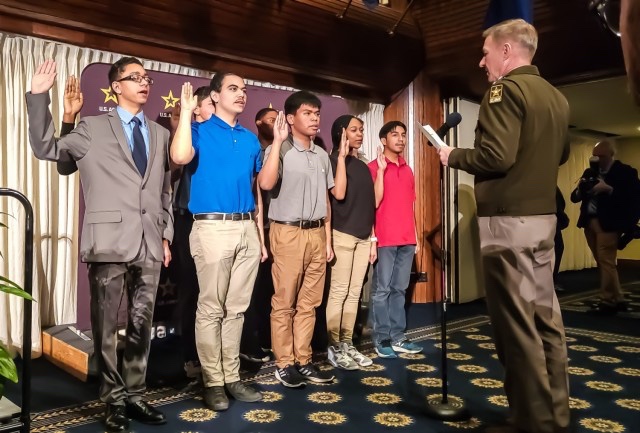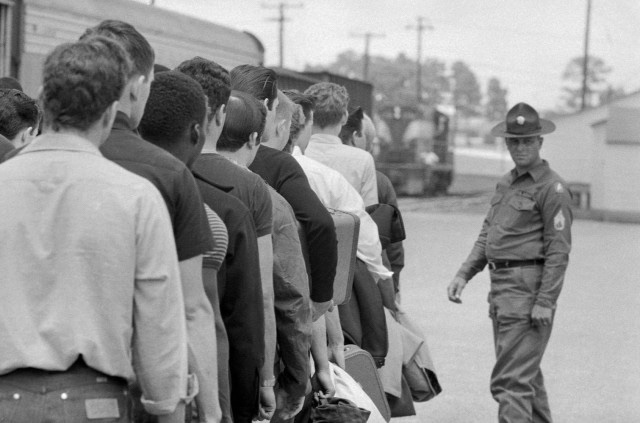
(Photo Credit: Photo by Doug Ware, Courtesy of Stars and Stripes, all rights reserved)
WASHINGTON — On July 1, 2023, the U.S. Army and the nation celebrated the 50th Anniversary of the all-volunteer force. For half a century, the call to serve has been answered with Americans making the choice to represent the highest ideals of service and patriotism through military service.
“This year is the 50th anniversary of the all-volunteer force,” said Secretary of the Army Christine Wormuth during the Army’s Birthday Festival. “That is 50 years of selfless service, 50 years of Soldiers from all walks of life volunteering to realize their potential, 50 years of Soldiers being all they can be.”
In 1973, the Nixon administration announced the U.S. military would fill its ranks exclusively with Americans that made the choice to serve rather than with draftees. Prior to 1973’s all-volunteer force, a near-continuous conscription began with President Franklin D. Roosevelt’s activation of the nation’s first peacetime draft in support of World War II. That first draft, between November 1940 and October 1946, enlisted over 10 million Americans. The draft was again re-adopted in 1948 and continued to exist until it was officially halted on July 1, 1973.

(Photo Credit: Photo by Warren Leffler, courtesy of the Library of Congress)
The Army started working on developing the all-volunteer force well before the draft ended. According to Nicholas Torre, an Army Historian with the U.S. Army Center of Military History, in April 1971, a transitionary program called VOLAR, named for the new Volunteer Army Program, was successfully implemented at select bases. VOLAR was an experiment designed to increase retention rates and morale among Soldiers and to attract those who wanted to serve. The results were promising. For example, reforms at Fort Carson that aligned with the principles of VOLAR resulted in a 45% increase of reenlistments.
“VOLAR and accompanying initiatives sought to rectify the ills of the Vietnam-era draft-dependent Army,” said Torre. The Army wanted to find ways to increase discipline and morale as it moved towards an all-volunteer force. That included improving work environments by focusing on three areas: Army professionalism, day-to-day quality of life and addressing contextual social problems like race-related and drug abuse issues. Today, at the close of the Global War on Terror and with recruitment presenting challenges, there are parallels shared between the inception of the all-volunteer force and the present state. For instance, the U.S. Army’s continues to be a diverse force and a place for equal pay and treatment.
“Our Soldiers, from the newest E-1 to the most experienced generals come from all over the country, from many different backgrounds, from multiple demographics, races and ethnicities. And while our Soldiers are as diverse as the nation they serve, we have seen throughout our history that we are strongest when we serve together. At the end of the day, what unites us is our shared Army values. That and our collective mission to fight and win the nation’s wars,” said Wormuth.
Our diverse force continues to be united by a common mission, but the U.S. Army has also evolved over the last 50 years. Under the draft system, draftees usually served for two years. Today enlistments vary depending on each Soldier’s training and career path. Today’s Army offers more complex education and training for over 200 career paths. New innovations in training such as the Holistic Health and Fitness, new approaches towards mental readiness, sleep readiness, physical readiness and spiritual readiness are telling of how today’s Army is prioritizing setting up Soldiers for readiness and success.
“No other organization can bring out the best in people like the United States Army,” Chief of Staff of the U.S. Army Gen. James C. McConville remarked at the Army’s Birthday Festival.
Wormuth succinctly expressed what’s at the core of encouraging and celebrating Americans who choose to serve in an Army of possibilities, “The strength of our total Army has always been and will always be, our people.”
By Corinne Dionisio


“On July 1, 2023, the U.S. Army and the nation celebrated the 50th Anniversary of the all-volunteer force.”
And it only took an election, a bioweapon, and 3 years of pledging allegiance to rainbow jihad to kill it. Bravo DOD. Bravo. [Golf Clap]
The Army met and even exceeded its recruiting quota in 2020 and 2021. The reason recruiting dropped like a rock is that the DOD’s new medical history software, MHS Genesis, pretty much precludes people lying about medical history to join. So now the host of minor stuff people used to lie about to join like a sprained wrist in high school or ADD absolutely NEEDS a waiver and that takes months. The normal barrier to entry being enforced has had a disastrous effect because now recruiters have to fight for waivers and to keep potential soldiers interested.
https://www.militarytimes.com/news/your-military/2023/04/10/the-genesis-of-todays-recruiting-crisis/
If you google “MHS Genesis recruiting” you’ll get several articles like this.
Keep telling to yourself ya Schmuckatelli!
Good, patriotic, God fearing Americans are no longer wanted by this “woke” of a joke Govt.
Save us all and kill yourself first, just sayun
Probably about time to turn comments off again…
I’m retiring after 21 years of service, the young people coming in now are just as patriotic hardworking etc as any I have known in my time.
You sound like someone who has not been in for a long time and probably never was to start with.
>Lawrence said Genesis “is not the root cause behind the Services failing to meet their recruiting mission,” but she did not respond by Military Times’ deadline to emailed follow-up questions directly asking if the Pentagon believes Genesis was playing a role in the recruiting crisis.
>Lawrence blamed, in part, low willingness of young people to serve, as well as “the residual effects” of the COVID pandemic that prevented recruiters “from meeting with youth and their influencers in our high schools.
Looks like your theory is wrong, did you even read your own article?
Oh look, a supporter of sedition, conspiracy theories, and hateful bigotry decided to throw in his two cents. You must hate America and our freedoms that US service members gave their lives for.
Army met the goals by lowering standards. Prove me wrong. Even SECDEF acknowledged again today that 77% of the overall pool are not eligible to serve. We aren’t recruiting the people we need and all the BS has hurt with recruiting from the eligible pool. That’s just a fact.